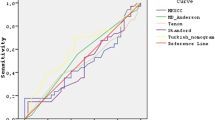Abstract
Introduction: Sentinel lymph node dissection (SLND) is becoming a recognized technique for accurately staging patients with breast cancer. Its success in patients with large tumors or prior excisions has been questioned. The purpose of this study was to evaluate the effect of biopsy method, excision volume, interval from biopsy to SLND, tumor size, and tumor location on SLND success rate.
Methods: Consecutive patients who underwent SLND followed by completion axillary lymph node dissection from October 1991 to December 1995 were analyzed. Included were cases performed early in the series before the technique was adequately developed. Excision volume was derived from the product of three dimensions as measured by the pathologist. Two end points were analyzed: sentinel node identification rate and accuracy of SLND in predicting axillary status. Univariate analyses using x2 or Fisher’s exact test for categorical variables and Wilcoxon rank sums for continuous variables were performed. Multivariate analysis was performed using logistic regression.
Results: There were 284 SLND procedures performed on 283 patients. Median age was 55 years. The most recent biopsy method used before SLND was stereotactic core biopsy in 41 (14%), fine-needle aspiration in 62 (22%), and excision in 181 (64%) procedures. The mean excision volume was 32 ml with a range of 0.3–169 ml. The mean time from biopsy to SLND was 17 days with a range of 0–140 days. The mean tumor size was 2.0 cm (15 Tis [5%], 184 T1 [65%], 72 T2 [25%], and 13 T3 [5%]). Tumors were located in the outer quadrants in 74%, the inner quadrants in 18%, and subareolar region in 8%. The sentinel node was identified in 81%, and 39% had metastases. There were three false-negative cases early in the series. Sensitivity was 97%, and accuracy was 99%. Negative predictive value was 98% in cases in which the sentinel node was identified. On the basis of biopsy method, excisional volume, time from biopsy to SLND, tumor size, and tumor location, there was no statistically significant difference (P..05) in sentinel node identification rate or accuracy of SLND.
Conclusions: SLND has a high success rate in breast cancer patients regardless of the biopsy method or the excision volume removed before SLND. In addition, the interval from biopsy to SLND, tumor size, and tumor location have no effect on the success rate of SLND, even in this series which included patients operated on before the technique was adequately defined. Patients with breast cancers located in any quadrant and diagnosed either with a needle or excisional biopsy could be evaluated for trials of SLND.
Similar content being viewed by others
REFERENCES
Giuliano AE, Kirgan DM, Guenther JM, Morton DL. Lymphatic mapping and sentinel lymphadenectomy for breast cancer. Ann Surg 1994;220:391–398.
Giuliano AE. Sentinel lymphadenectomy in primary breast carcinoma: an alternative to routine axillary dissection. J Surg Oncol 1996;62:75–77.
Giuliano AE, Jones RC, Brennan M, Statman R. Sentinel lymphadenectomy in breast cancer. J Clin Oncol 1997;15:2345–2350.
Morton DL, Wen DR, Wong JH, et al. Technical details of intraoperative lymphatic mapping for early stage melanoma. Arch Surg 1992;127:392–399.
Giuliano AE, Dale PS, Turner RR, et al. Improved axillary staging of breast cancer with sentinel lymphadenectomy. Ann Surg 1995;222:394–399.
Albertini JJ, Lyman GH, Cox C, et al. Lymphatic mapping and sentinel node biopsy in the patient with breast cancer. JAMA 1996;276:1818–1822.
Veronesi U, Paganelli G, Galimberti V, et al. Sentinel-node biopsy to avoid axillary dissection in breast cancer with clinically negative lymph-nodes. Lancet 1997;349:1864–1867.
Borgstein PJ, Pijpers R, Comans EF, et al. Sentinel lymph node biopsy in breast cancer: guidelines and pitfalls of lymphoscintigraphy and gamma probe detection. J Am Coll Surg 1998;186:275–283.
Ollila DW, Giuliano AE. Intraoperative lymphatic mapping and sentinel lymphadenectomy using isosulfan blue dye. Breast Dis 1998;8:297–300.
American Joint Committee on Cancer. Manual for staging of cancer. 4th ed. Philadelphia: Lippincott, 1992.
Cox CE, Pendas S, Cox JM, et al. Guidelines for sentinel node biopsy and lymphatic mapping of patients with breast cancer. Ann Surg 1998;227:645–653.
O’Hea BJ, Hill AD, El-Shirbiny AM, et al. Sentinel lymph node biopsy in breast cancer: initial experience at Memorial Sloan-Kettering Cancer Center. J Am Coll Surg 1998;186:423–427.
Barnwell JM, Arredondo MA, Kollmorgen D, et al. Sentinel node biopsy in breast cancer. Ann Surg Oncol 1998;5:126–130.
Krag D, Weaver D, Ashikaga T, et al. The sentinel node in breast cancer: a multicenter validation study. N Engl J Med 1998;339:941–946.
Miner TJ, Shriver CD, Jaques DP, et al. Ultrasonographically guided injection improves localization of the radiolabeled sentinel lymph node in breast cancer. Ann Surg Oncol 1998;5:315–321.
Offodile R, Hoh C, Barsky SH, et al. Minimally invasive breast carcinoma staging using lymphatic mapping with radiolabeled dextran. Cancer 1998;82:1704–1708.
Roumen RM, Valkenburg JG, Geuskens LM. Lymphoscintigraphy and feasibility of sentinel node biopsy in 83 patients with primary breast cancer. Eur J Surg Oncol 1997;23:495–502.
Borgstein PJ, Meijer S, Pijpers R. Intradermal blue dye to identify sentinel lymph-node in breast cancer. Lancet 1997;349:1668–1669.
Krag DN, Weaver DL, Alex JC, Fairbank JT. Surgical resection and radiolocalization of the sentinel lymph node in breast cancer using a gamma probe. Surg Oncol 1993;2:335–340.
Turner-Warwick RT. The lymphatics of the breast. Br J Surg 1953;46:574–582.
Vendrell-Torne E, Setoin-Quinquer J, Domenech-Torne FM. Study of normal mammary lymphatic drainage using radioactive isotopes. J Nucl Med 1972;13:801–805.
De Cicco C, Cremonesi M, Luini A, et al. Lymphoscintigraphy and radioguided biopsy of the sentinel axillary node in breast cancer. J Nucl Med 1998;39:2080–2084.
Turner RR, Ollila DW, Krasne DL, Giuliano AE. Histopathologic validation of the sentinel lymph node hypothesis for breast carcinoma. Ann Surg 1997;226:271–278.
Author information
Authors and Affiliations
Rights and permissions
About this article
Cite this article
Haigh, P.I., Hansen, N.M., Qi, K. et al. Biopsy Method and Excision Volume Do Not Affect Success Rate of Subsequent Sentinel Lymph Node Dissection in Breast Cancer. Ann Surg Oncol 7, 21–27 (2000). https://doi.org/10.1007/s10434-000-0021-1
Received:
Accepted:
Issue Date:
DOI: https://doi.org/10.1007/s10434-000-0021-1




